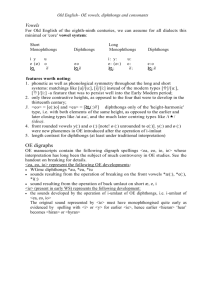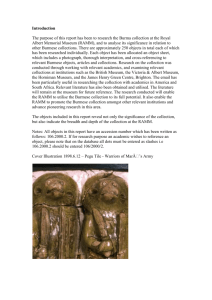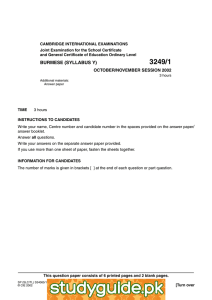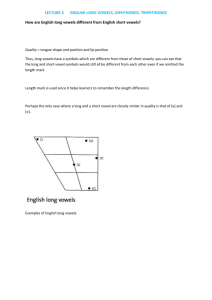F B –
advertisement
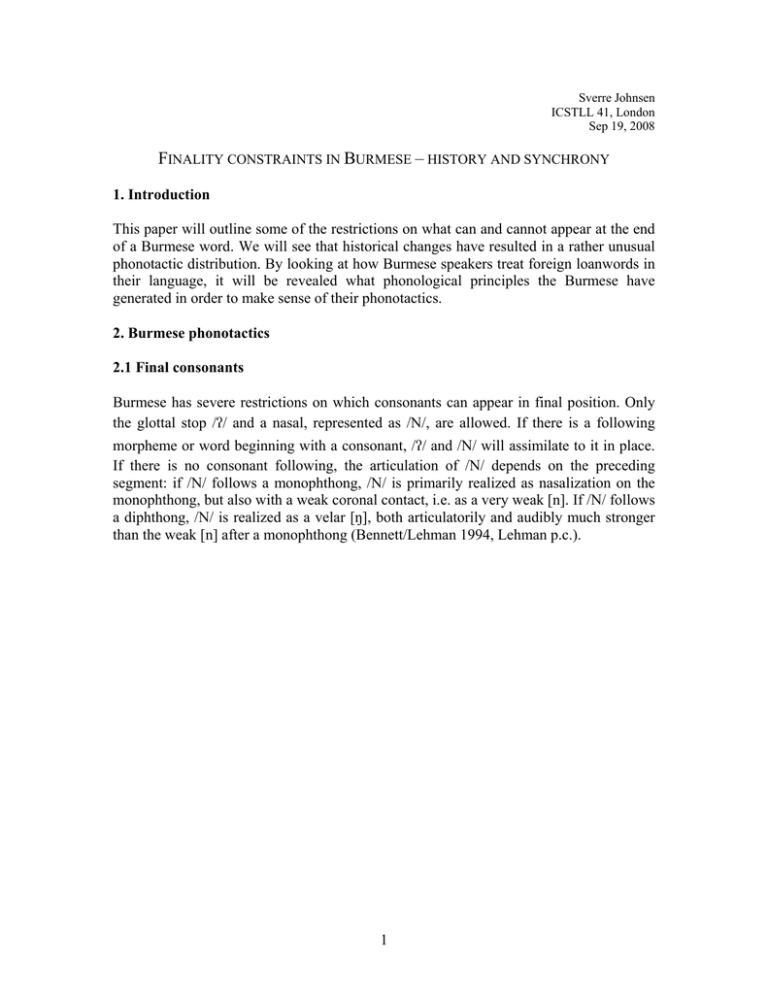
Sverre Johnsen ICSTLL 41, London Sep 19, 2008 FINALITY CONSTRAINTS IN BURMESE – HISTORY AND SYNCHRONY 1. Introduction This paper will outline some of the restrictions on what can and cannot appear at the end of a Burmese word. We will see that historical changes have resulted in a rather unusual phonotactic distribution. By looking at how Burmese speakers treat foreign loanwords in their language, it will be revealed what phonological principles the Burmese have generated in order to make sense of their phonotactics. 2. Burmese phonotactics 2.1 Final consonants Burmese has severe restrictions on which consonants can appear in final position. Only the glottal stop /ʔ/ and a nasal, represented as /N/, are allowed. If there is a following morpheme or word beginning with a consonant, /ʔ/ and /N/ will assimilate to it in place. If there is no consonant following, the articulation of /N/ depends on the preceding segment: if /N/ follows a monophthong, /N/ is primarily realized as nasalization on the monophthong, but also with a weak coronal contact, i.e. as a very weak [n]. If /N/ follows a diphthong, /N/ is realized as a velar [ŋ], both articulatorily and audibly much stronger than the weak [n] after a monophthong (Bennett/Lehman 1994, Lehman p.c.). 1 2.2 Vowel inventory The following tables show the phonetic distribution of vowels in Burmese: Open syllables i e ε u o ɔ a Syllables closed by /N/ ɪ ʊ ʌ ej ow aj aw ej ow aj aw Syllables closed by /ʔ/ ɪ ʊ ε ʌ There are two quite noticeable asymmetries in the distribution of vowels: 1) There are no diphthongs in open syllables 2) There is a front mid vowel /ε/ before /ʔ/, but no back mid */ɔʔ/ 3. Historical origin of Burmese phonotactics An important part of the explanation for why the phonology of a language is the way it is is to understand how it came to be. The following summary of the relevant sound changes builds primarily on the discussion in Maran 1971. For the historical discussion, it is important to realize that Written Burmese (WB) represents a much earlier stage of the current Standard Burmese (SB) language. 3.1 Final consonants Already before WB, the liquids /l/ and /r/ were lost in final position, leaving stops and nasals as the available final consonants. In the series of stops and nasals, the labial /p/ and /m/ were lost. The remaining dental /t/~/n/ and velar /k/~/ŋ/ were distributed primarily based on the quality of the preceding vowel. Finally, the stops /t/ and /k/ have both been depleted to /ʔ/ in SB. The nasals /n/ and /ŋ/ have given SB /N/ as discussed above. 2 -l, -r -p/-t/-k -m/-n/-ŋ > > > Ø -t/-k -n/-ŋ > > -ʔ -N 3.2 Vowels To understand the SB phonotactics, the development of vowels in their interaction with the consonants is central. First, the original diphthongs /ai/, /au/ and /iu/ were monophthongized to /ε/, /ɔ/ and /o/. At this stage, Burmese has only monophthongs. By the gradual loss of final consonants, Burmese distinguishes at this stage only between dental and velar stops and nasals: /-t/~/-n/ and /-k/~/-ŋ/. The SB diphthongs arose through a process in which all vowels except /a/ diphthongized before a velar consonant, i.e. before /-k/ and /-ŋ/. The following examples will illustrate the different behavior of vowels before a velar /-k/ and a dental /-t/: /-εk/ > /-εt/ > /-ik/ > /-it/ > /-uk/ > /-ut/ > /-ajk/ > /-ajʔ/ /-εʔ/ /-ejk/ > /-ejʔ/ /-ɪʔ/ /-owk/ > /-owʔ/ /-ʊʔ/ Since this diphthongization only occurred before a velar consonant, and this velar consonant is preserved in SB as /-ʔ/ or /-N/, it follows that Burmese diphthongs do not exist in open syllables. 3.3 Dental and velar /N/ The diphthongization process outlined above gives an explanation for the realization of /N/ in SB. As mentioned in 2.1, /N/ is realized as a weakly articulated [n] after monophthongs, and as a more strongly articulated [ŋ] after diphthongs: /ɪN/ /ejN/ = [ĩn] = [ẽjŋ] Synchronically, this distribution seems unnatural, since a velar realization of a nasal following a palatal glide [j] can hardly be seen as an assimilatory or coarticulatory pronunciation. With a diachronic perspective, however, the velar realization of /N/ after diphthongs is simply the retention of the original pronunciation. Since vowels became diphthongs 3 before /ŋ/, but not before /n/, it automatically follows that diphthongs are followed by [ŋ], and other vowels by [n]. 3.4 /εʔ/ but no */ɔʔ/ There seems to be a gap in the Burmese repertoire of vowel followed by a glottal stop. Among the high vowels, both the front and back /ɪ/ and /ʊ/ occur before /ʔ/. Among the mid vowels, however, only the front /ε/ exists before /ʔ/. There are no SB words ending in */-ɔʔ/. Again, from a synchronic perspective, this seems unnatural, since there is no phonological or phonetic oddity about /ɔʔ/ as opposed to /εʔ/. Diachronically, however, this has a natural explanation. First, in WB, the only vowels that occur before a consonant are /i/, /u/ and /a/. When followed by the velar /k/, /i/ and /u/ diphthongized to /ej/ and /ow/, as explained above. /ak/, however, underwent a common process of vowel fronting/raising before velars, and developed to /ek/. By the largely allophonic distribution of /k/ and /t/ at this stage of Burmese, /ek/ changes to /et/, which ultimately gives SB /εʔ/ (Maran 1971). Given the history of Burmese, the only natural candidate for SB */ɔʔ/ would be if an original /uk/ or /ut/ underwent lowering to /ok/ ~ /ot/, which by the same rules as described above would develop to /ot/ and finally SB */ɔʔ/. Whereas vowel fronting and raising before velars is cross-linguistically common, the same cannot be said about the hypothetical ‘lowering before velars/dentals’. In fact, no such process took place in the history of Burmese, so the lack of SB */ɔʔ/ has a natural explanation. 3.5 Summary The phonotactic distribution in SB seems at first hand somewhat ‘unnatural’, exhibiting diphthongs only in closed syllables, and having the sequence /εʔ/, but not the back equivalent */ɔʔ/. The historical development of Burmese gives a natural explanation for the current distribution: Diphthongs exist only in closed syllables because vowels diphthongized only before original velar consonants. */ɔʔ/ does not appear in SB because it could have evolved only through a phonetically ‘unnatural’ process. 4. Derivation or memorization? With respect to the final segments of SB words, there are no morphological processes in Burmese that will add or remove final consonants, thereby creating an interplay between open and closed syllables. As a result, the phonotactic distribution is static. The question now becomes whether Burmese speakers have generated any kind of principle or generalization out of this static distribution, or if the native words are simply memorized in their forms. As will become clear in the following, speakers have indeed 4 created phonological principles on the basis of what the historical developments have resulted in. Given the static distribution in Burmese, the testing ground for our question of synchronic principles is loanword phonology. Loanwords serve in effect as the input, or the ‘underlying form’, and the Burmese nativization of the loanwords is produced by applying native phonological principles to the input forms. We can discover the active phonological principles of Burmese by investigating what happens to loanwords which one would expect would give final diphthongs and final /-ɔʔ/ (the examples come from my own elicitations and Chang 2003). 5. Loanword phonology – diphthongs Focusing on the diphthongs /ej/ and /ow/, it comes as no surprise that Burmese faithfully retains these diphthongs from English in a closed syllable (superscript numbers denote tones):1 ‘cake’ /kejʔ/ ‘oats’ /ʔowʔ/ ‘gate’ /gejʔ/ ‘phone’ /phowN3/ In an open syllable, however, the Burmese mapping mimics the native lexicon by not allowing diphthongs to appear: ‘café’ /ka2pe3/ ‘banjo’ /bʌN2d͡ʒo2/ ‘DJ’ /di2d͡ʒe2/ ‘dingo’ /dɪN2go2/ As we can see in the words above, /ej/ and /ow/ become /e/ and /o/ in an open syllable. As to what the proper analysis of this process is, there seem to be two available alternatives: 1) Diphthongs are mapped to monophthongs in open syllables because diphthongs and monophthongs are allophones of underlying phonemes /e/ and /o/ 2) Diphthongs are mapped to monophthongs by deletion of the final glide 5.1 Allophony The easiest solution seems to be to assume an allophonic distribution of the diphthongs /ej/, /ow/ and the monophthongs /e/, /o/. In other words, the syllable structure, i.e. whether the syllable is open or closed, determines whether the diphthongs /ej/, /ow/ or the monophthongs /e/, /o/ surface. Although this has been the general approach in the literature (cf. the summaries in Mehnert/Richter 1972-77 and Green 2005), it will make the wrong predictions. 1 Due to space and time limitations, this paper does not discuss the diphthongs /aj/ and /aw/, which behave differently in loanword phonology from /ej/ and /ow/. 5 Since SB has no mid vowels before /N/, only diphthongs, the allophony analysis predicts that an input with mid vowels before a nasal will result in SB /-ejN/ and /-owN/. As the following examples show, this is not the case: ‘November’ /no2wɪN2ba2/ ‘ball pen’ /bɔ3pɪN2/ ‘John’ /d͡ʒʊN2/ ‘sitcom’ /sɪʔkʊN2/ If diphthongs were the allophonic variant of mid vowels before a nasal, we would expect */no2wejN2ba2/ ‘November’ and */d͡ʒowN2/ ‘John’ as outcomes. Since this does not occur, the conclusion should be that the diphthongs are phonological sequences in their own right, not mere phonetic variants of mid vowels. 5.2 Glide deletion As the phonetic transcriptions of SB so far have revealed, the first element of the diphthongs /ej/ and /ow/ is qualitatively identical to the monophthongs /e/ and /o/, further confirmed by the phonetic studies in Mehnert/Richter 1972-77. It follows that deleting the final glide in /ej/ and /ow/ will give the outputs /e/ and /o/. Glide deletion would make no prediction of input mid vowels /e/ and /o/ mapping to diphthongs /ej/ and /ow/ before a nasal, as that would constitute the opposite phenomenon of ‘glide insertion’. A mapping of ‘John’ to /d͡ʒʊN2/ is therefore expected under this approach. As a consequence, I claim that glide deletion is the correct analysis of loanword mappings such as /ka2pe3/ from ‘café’. I will show in the following that this analysis can be backed up by similar phenomena in Burmese. 6. Deletion of final segments It will be supportive of the analysis of glide deletion if it can be shown that Burmese independently of these cases exhibit deletion of final segments in similar derivations. As this section will show, this is the case. Recall that final /-l/ and /-r/ were lost already before WB. Although both segments are available in SB, they do not occur in final position in the native lexicon. The following loanword mappings show that this native distribution is mimicked, and that the process undertaken is deletion of both /-l/ and /-r/: ‘e-mail’ ‘car’ /ʔi3me3/ /ka3/ ‘Nicole’ ‘store’ /ni2ko3/ /səto3/ It is safe to conclude from these examples that there is a synchronic ban on final liquids (/l/ and /r/) in Burmese, and that this ban leads to deletion of these segments if they were to end up in a final position. 6 6.1 Glides and consonants There is an absolute identity between the process of deleting a final glide and the process of deleting a final liquid, and it is therefore natural to assume that they in fact are the same process. Instead of listing them as two separate deletion processes in the synchronic grammar of Burmese, I will follow the assumption that they are the result of a single phonological principle. The question thus becomes how glides and liquids can be captured as one phonological class of segments. Glides are in fact notoriously difficult to classify phonologically. It is often said that their behavior is somewhere ‘in between’ vowels and consonants. It has been pointed out several times in recent literature that glides in some languages clearly behave as consonants, and not merely as surface realizations of underlying vowels (cf. Levi 2004, Levi in press, Lingua 2007). I will leave aside a further discussion of this issue, and will take it as a fact that glides can, and in some cases must, be phonological consonants. As a result, the liquids /l/, /r/ and the glides /j/, /w/ can be captured as a single phonological class: consonantal oral sonorants. The phonological process of final deletion in Burmese targets this class, correctly predicting that only these segments are always deleted from the final position. 6.2 Burmese glides Although it is perfectly possible that the evidence for glides being consonants comes from one process only, such as deletion of final sonorants, it would naturally be beneficial for the theory if it were necessary to refer to glides as consonants also in other positions in Burmese, independent of the cases already discussed. A basic diagnostics for identifying consonantal glides is if glides ‘over-abound’, meaning that glides surface in positions where we otherwise would expect high vowels (cf. Levi 2004). Such a case would be if a sequence /jCV/ surfaces instead of /iCV/. Given that the only onset clusters in Burmese are the ones with /w/ as a second element (Cornyn 1944), the only place we would detect the sequence in question would be if there existed an onset /jwV/. And indeed, this is a common onset in Burmese, seen in e.g. /jwa1/ ‘be fragile, /jwa2/ ‘village’, /jwe1/ ‘move’, /jwe3/ ‘choose’, /jwε1/ ‘be across’, /ʔəjwe2/ ‘age’, /jwεʔ/ ‘carry on the head’ etc. (Bernot 1989). In these cases, it is necessary to specify /j/ as a consonant in order to prevent it from surfacing as a vowel. The behavior of the onset consonant cluster /jw/ supports therefore the analysis of glides being consonants in Burmese. In fact, there are no indications that glides ever behave as vocoids (i.e. underlying vowels) in Burmese. Since there on the other hand is good evidence for glides behaving as consonants, the easiest assumption for a Burmese speaker is thus to analyze all glides as consonants. 6.3 Origin of consonantal glides It is a natural assumption that when glides behave as consonants in a linguistic process, it stems from the fact that these glides originate from ‘real’ consonants in this position at a 7 previous stage of the language. In Burmese, then, it seems as if glides behave as consonants in final position, and initially in the cluster /jw-/. In final position, glides are not allowed to appear, and they simply never existed in this position, since the present diphthongs in SB originated before velar consonants. The lack of final glides simply mimics that fact that there are no final oral consonants in SB. In the initial /jw-/ cluster, however, the prediction would be that the consonantal behavior of /j/ is due to an origin as a ‘real’ consonant. As is well known, the frequent /jw-/ cluster has evolved from an original sequence /rw-/, as it is still represented in WB. The consonantal origin of the initial glide here thus gives a natural explanation for its behavior in SB, and adds support to a phonological analysis of the glide as a consonant. 6.4 Summary Analyzing the mapping of final diphthongs /ej/ and /ow/ to /e/ and /o/ as a result of glide deletion is supported by the fact that an identical final deletion process takes place with final /l/ and /r/. I propose that a single phonological process targets glides and liquids by referring to them as consonantal oral sonorants. Analyzing glides as consonants can be supported by the behavior of /j/ elsewhere, where it originates from a consonant /r/. 7. Loanword phonology – /-ɔʔ/ As shown in 2.2 and explained in 3.4, the native lexicon of Burmese does not exhibit the sequence /-ɔʔ/. In the same manner as with final diphthongs, we want to know whether this fact is something Burmese speakers have incorporated into their active phonology, or if it is simply a fact of history with no consequences for current processes. The testing ground is again loanword phonology, for reasons explained above. As several nativizations of loanwords in section 5 have revealed, final oral obstruents (stops and fricatives) are mapped to SB /-ʔ/. Given the appearance of /-εʔ/ in Burmese, we correctly predict that an English lax /e/ followed by an obstruent gives Burmese /-εʔ/: ‘cigarette’ /si3kəɾεʔ/ ‘Mexico’ /mεʔshi2ko2/ When English lax /o/ is followed by an obstruent, on the other hand, the loanword mapping mimics the native static distribution, and /-ɔʔ/ does not surface. Instead, the final obstruent is deleted: ‘hot dog’ /hɔ1 dɔ1/ ‘jackpot’ /d͡ʒʌʔpɔ1/ ‘Adolf’ /e2dɔ1/ ‘fork’ /phɔ1/ In order to avoid a final sequence /-ɔʔ/, the final deletion process goes further than just targeting consonantal sonorants, as in /bɔ3/ ‘ball’. In these cases, the final deletion applies 8 to any oral consonant, although for two different reasons. One is motivated by avoiding a final glide or liquid, as this does not occur in SB. The other is motivated by avoiding a final sequence /-ɔʔ/. Since /ɔ/ is the only vowel where one would ‘expect’ /ʔ/ to be able to follow, and it does not, it naturally follows that deletion of /ʔ/ occurs only in this case. 8. Conclusion Burmese has a rather unusual distribution of certain phonotactic sequences, in that it has diphthongs only in closed syllables, and that it has the sequence /-εʔ/ with a front vowel, but not /-ɔʔ/ with a back vowel. A survey of the historical source of these sequences in Burmese reveals that the origin of the current distribution is quite natural. Loanword phonology reveals that the native static phonotactics is mimicked when adopting new words into the language. In essence, no new words are allowed to have a form that the Burmese linguistic history could not also have given. This shows that Burmese speakers have not merely memorized the phonotactics of their lexicon, but they have established active phonological principles to ‘account for’ their own phonological system. I have proposed in this paper that these principles include referring to glides as consonants, and employing final deletion as a default mechanism to obtain a tolerable shape of the word. Exactly how these ‘phonological principles’ are represented in phonological theory is more a matter of formalism and notation than descriptive or explanatory adequacy. The ban on certain surface sequences and how these bans are obeyed can easily be translated into an OT system of constraint ranking, but since such a notation only reformulates the descriptive properties already established, it is considered tangential to the purpose of this paper, which has been to show that Burmese speakers have ‘duplicated’ the historical information of their language into a synchronic active phonology. Please direct comments and questions to: Sverre Johnsen Department of linguistics Harvard University E-mail: johnsen@fas.harvard.edu References Bennett, J. F./Lehman, F. K. 1994. Towards an optimality-theoretic account of Burmese sandhi effects. Paper presented at Southeast Asian linguistics society IV. Bernot, Denise. 1989. Dictionnaire birman-français (fascicule 13). Paris. Chang, C. B. 2003. “High-interest loans”: The phonology of English loanword adaptation in Burmese. BA thesis, Harvard. Cornyn, W. 1944. Outline of Burmese grammar. Language 20:5-34. Green, A. D. 2005. Word, foot, and syllable structure in Burmese. In J. Watkins (ed.): Studies in Burmese linguistics. Canberra: Pacific Linguistics, 1-25. 9 Levi, S. 2004. The representation of underlying glides: a cross-linguistic study. PhD. dissertation, University of Washington. Levi, S. (in press). Phonemic vs. derived glides. Lingua 2007. Lingua 2007 (in press). Volume with papers from the workshop “Towards a phonetic and phonological typology of glides”. Maran, L. R. 1971. Burmese and Jingpho: A study of tonal linguistic processes. Urbana. Mehnert, D./Richter, E. 1972-77. Untersuchungen zur Phonetik und Phonologie des modernen Burmesischen. Zeitschrift für Phonetik, Sprachwissenschaft und Kommunikationsforschung 25:306-325, 26:675-690, 29:145-166, 30:514-534. 10

